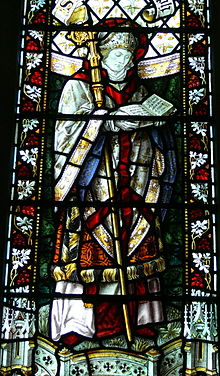Saint Asaph
| Saint Asaph | |
|---|---|

St. Asaph window, St. David's Cathedral
|
|
| Bishop | |
| Born | early 6th century what is now Northern England |
| Died | 1 May 596 St Asaph, Flintshire |
| Venerated in |
Eastern Orthodox Church Roman Catholic Church Anglican Communion |
| Major shrine | St Asaph Cathedral, Flintshire (destroyed) |
| Feast | 1 May, 5 May, 11 May |
| Attributes | Bishop with a book, or monk carrying hot coals |
| Patronage | St Asaph |
Saint Asaph (or Asaf, Asa) was, in the second half of the 6th century, the first Bishop of St Asaph, i.e. bishop of the diocese of Saint Asaph.
No traditional Welsh account devoted to the life of Asaph exists. He is, though, well-attested to through place names. Local tradition points out many landmarks attested to him; his ash tree, his church, his well and his Valley. Many local names bear the "asa" associated with his name; Onnen Asa, Ffynnon Asa, Llanasa, Pantasa. All these sites are near Holywell in Tegeingl (Flintshire), indicating probably that the saint may once have had a hermitage in that area. The Bonedd y Saint tells us that he was a son of King Sawyl Penuchel from the Old North or Yr Hen Ogledd; his mother was said to be Gwenaseth, daughter of Rhufon Rhufoniog.
The want of a Welsh Life, however, is in part compensated for by Jocelyn of Furness's Life of St. Kentigern, which tells the story of Cyndeyrn (Kentigern) alias Saint Mungo, the founder of the Diocese of Glasgow. During his exile (c. 545), Kentigern took himself to Wales and there founded the Celtic Monastery of Llanelwy (the church on the River Elwy), as the Welsh still call the city of St Asaph. Llanelwy is among the best documented of Celtic monasteries: the church was described as built "of smoothed wood, after the fashion of the Britons, seeing that they could not yet build of stone". The 965 disciples, of whom Asaph was one, were divided into three groups: 300 of the unlettered farmed the outlying lands, 300 worked in the offices around the monastery, and 365 (the number corresponds to the days of the year) attended to the divine services. Of these the oldest assisted Kentigern in the government of the diocese, and the rest were subdivided into three choirs. "As soon as one choir had terminated its service in church, immediately another entering commenced it: and that again being concluded another entered to celebrate."
...
Wikipedia
